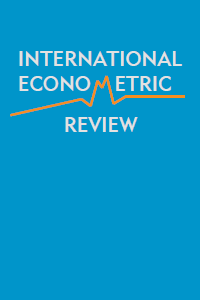Deterministic Effects of Volatility on Mixed Frequency GARCH in Means MIDAS Model: Evidence from Turkey
Deterministic Effects of Volatility on Mixed Frequency GARCH in Means MIDAS Model: Evidence from Turkey
Volatility is a key concept for understanding the dual relationships between the economic variables since it is inversely related to the stability of economies. Many models such as GARCH models have been constructed through time to understand which determinants and conditions can affect the volatility. These models mostly show the significant relationships between the volatilities generated by the low frequency macroeconomic activities and the high frequency financial variables in a stochastic way. However, it is required to check whether there exist deterministic effects of volatilities on high frequency economic variables. In order to reveal these deterministic effects, we developed a new component-wise model, namely GARCH-M MIDAS model. We formulate this model on stock prices and exchange rates, in which long run volatility is driven by consumer price and industrial production indexes in a separate way. Hence, our empirical analysis supports that both types of the volatilities have statistically significant deterministic effects on the asset pricing of high frequency financial variables. We also find that macroeconomic activities have a significant role on the asset pricing in long horizons.
Keywords:
MIDAS, GARCH-MIDAS, Long Run Short Run, Deterministic Effects,
___
- Adam T., Benecka S. & Mateju J. (2018). Financial Stress and its Non-Linear Impact on CEE Exchange Rates. Journal of Financial Stability, 36, 346-360.
- Adrian T. & Rosenberg J. (2008). Stock Returns and Volatility: Pricing the Short-Run and Long-Run Components of Market Risk. The Journal of Finance, 63(6), 2997-3030.
- Amendola A., Candila V. & Scognomillo A. (2017). On the Influence of US Monetary on Crude Oil Price Volatility. Empirical Economics, 52, 155-178.
- Apergis N. & Eleftheriou S. (2002). Interest Rates, Inflation and Stock Prices: The Case of the Athens Stock Exchange. Journal of Policy Modeling, 24, 231-236.
- Beltratti, A. & Morana, C., (2006). Breaks and Persistency: Macroeconomic Causes of Stock Market Volatility. Journal of Econometrics, 131(1), 151–177.
- Bollerslev, T., (1986). Generalized Autoregressive Conditional Heteroskedasticity. Journal of Econometrics, 31, 307-327.
- Bush G. & Noria G.L. (2021). Uncertainty and Exchange Rate Volatility: Evidence from Mexico. International Review of Economics and Finance, 75, 704-722.
- Campbell, J. Y., & Ludger H. (1992). No news is good news: An asymmetric model of changing Volatility in Stock Returns. Journal of Financial Economics, 31(3), 281-318.
- Chun D., Cho H & Ryu D. (2020). Economic Indicators and Stock Market Volatility in an Emerging Economy. Economic Systems, 44(2).
- Clarida, R., Davis, J., & Pedersen, L. (2009). Currency Carry Trade Regimes: Beyond the Fama Regression. Journal of International Money and Finance, 28, 1375–1389.
- Dupuy, P, James J. & Marsh I. W. (2021). Attractive and Non-Attractive Currencies. Journal of International Monetary and Finance, 110(C).
- Eichler, S. & Littke, H.C.N. (2018). Central Bank Transparency and the Volatility of Exchange Rates. Journal of International Money Finance, 89, 23–49.
- Engle, R.F. (1982). Autoregressive Conditional Heteroskedasticity with Estimates of the Variance of United Kingdom Inflation. Econometrica, 50, 987-1007.
- Engle R.F., Ghysels E. & Sohn B. (2013). Stock Market Volatility and Macroeconomic Fundamentals. The Review of Economics and Statistics, 95(3), 776-797.
- Engle, R., Lilien, D., & Robins, R. (1987). Estimating Time Varying Risk Premia in the Term Structure: The Arch-M Model. Econometrica, 55(2), 391-407.
- Engle R.F. & Rangel J.G. (2008). The Spline GARCH Model for Low Frequency Volatility and Its Global Macroeconomic Causes. Review of Financial Studies, 21, 1187-1220.
- Fang X. & Liu Y. (2021). Volatilities, Intermediaries and Exchange Rates. Journal of Financial Economics, 114, 217-233.
- Ghysels E., Santa-Clara P. & Valkanov R. (2004). The MIDAS Touch: Mixed Data Sampling Regression Models. UCLA:Finance. Retrieved from https://escholarship.org/uc/item/9mf223rs.
- Gordon, M.J., (1962). The Investment, Financing and Valuation of the Corporation. R.D. Irwin, Homewood, IL.
- Humpe, A., & Macmillan, P. (2009). Can Macroeconomic Variables explain Long-term Stock Market Movements? A Comparison of the US and Japan. Applied Financial Economics, 19, 111–119.
- Kaurijoki M., Nikkinen J. & Aijo J. (2014). Return-Implied Volatility Dynamics of High and Low Yielding Currencies. The Journal of the Future Markets, 35, 1026-1041.
- Lütkepohl, H., (1981). A Model for Non-Negative and Non-Positive Distributed Lag Functions. Journal of Econometrics, 16(2), 211-219.
- Menkhoff L., Sarno L.,Schmeling M. & Schrimpf A. (2012). Carry Trades and Global Foreign Exchange Volatility. The Journal of Finance, 67(2), 681-718.
- Molodtsova T & Papell D. (2009). Out of Sample Exchange Rate Predictability with Taylor Rule Fundamentals. Journal of International Economics, 77(2), 167-180.
- Pati P. C., Rajib P. & Barai P. (2019). The Role of the Volatility Index in Asset Pricing: The Case of the Indian Stock Market. The Quarterly Review of Economics and Finance, 336-346.
- Peiro A. (2015). Stock Prices and Macroeconomic Factors: Some European Evidence. International Review of Economics and Finance, 41, 287-294.
- Peng D., Wang J. & Rao Y. (2014). Applications of Nonferrous Metal Price Volatility to Prediction of China’s Stock Market. Transactions of Nonferrous Metal Society of China, 597-604.
- Tsagkanos A. & Siriopoulos C. (2015). Stock Markets and Industrial Production in North and South of Euro-Zone: Asymmetric Effects via Threshold Cointegration Approach. Journal of Economic Asymmetries, 12, 162-172.
- Xu Q., Bo Z.,Jiang J. & Liu Y.(2019). Does Google Search Index Really Help Predicting Stock Market Volatility? Evidence from the Modified Mixed Sampling Model on Volatility. Knowledge-Based Systems, 166, 170-185.
- ISSN: 1308-8793
- Başlangıç: 2009
- Yayıncı: Ekonometrik Araştırmalar Derneği
